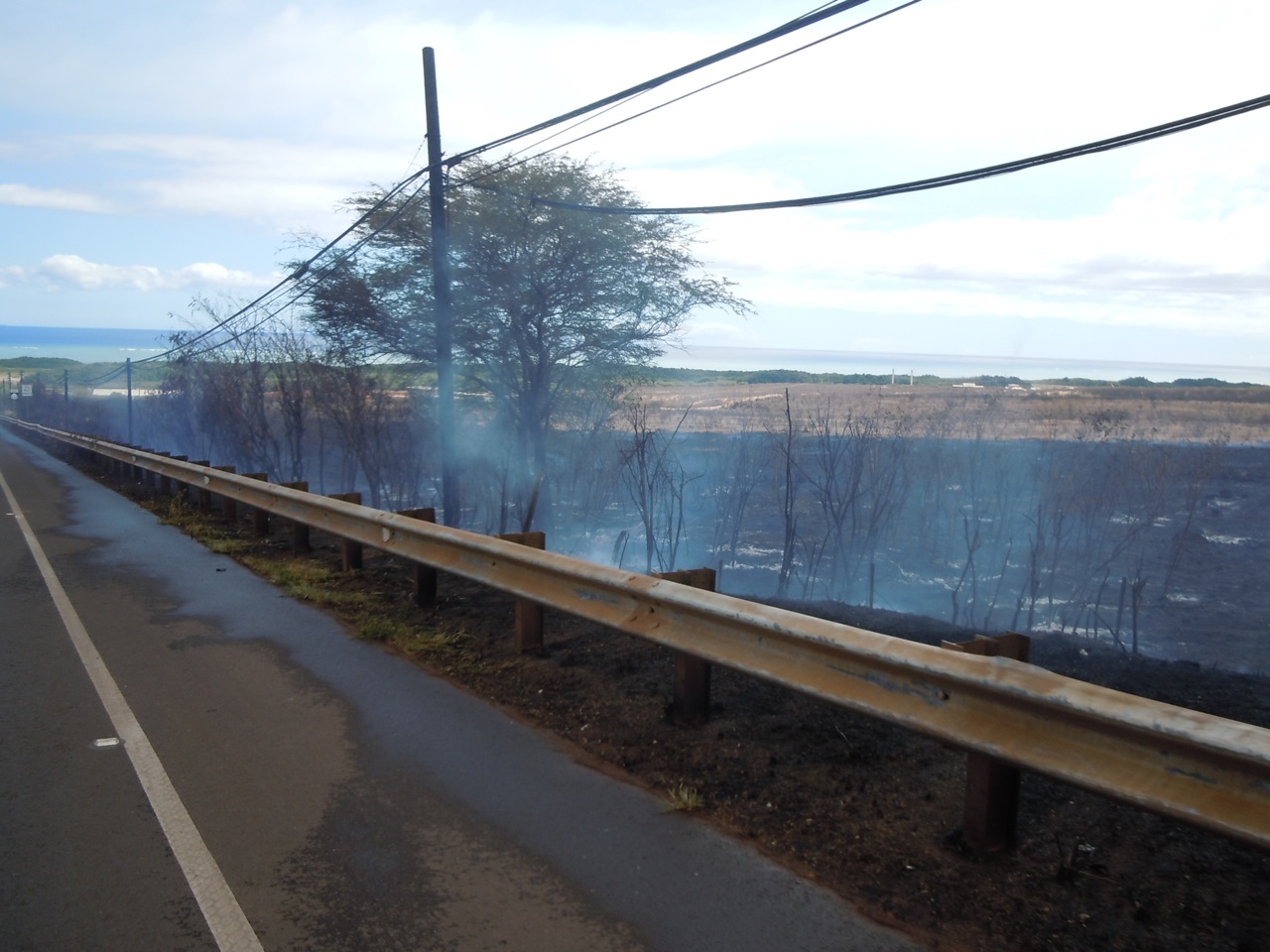Tuesday, August 30th, 2011
.jpg)
Molokai firefighters responded to three brush fires last Tuesday – for a total of five fires on the island within five days. Two fires burned over 20 acres along Maunaloa Highway three miles west of Kaunakakai Tuesday afternoon, causing a temporarily loss of phone and 911 service. Later that day, firefighters responded to a third, smaller blaze near the highway in west Molokai. Previously, on Thursday, Aug. 18, firefighters responded to two small fires also reported back to back, according to Molokai Fire Captain Travis Tancayo.
Local fire officials said they believe all five fires may have been set intentionally.
The first fire Tuesday was reported about 1:30 p.m. and burned 5,000 square feet just west of Hawaiian Research facilities. The second fire, reported within minutes of the first, burned about 20 acres nearby. Traffic was stopped on Maunaloa Highway for about one hour.
Because of rapid fire team response and favorable winds, the pair of fires Tuesday were contained within two hours, according to Molokai Fire Inspector Rick Schonely.
“If we had had regular trade winds that day, we could still be fighting it,” Schonely said on Friday.
All Molokai units and a total of 22 firefighters responded to the pair of fires, with air support from a Maui helicopter. Crews were also were assisted by the county Public Works Department and the Highways Division of the state Department of Transportation.
While no buildings were affected, fire damaged two fiber optic cables that provide phone service to much of the island, according to Hawaiian Telcom spokesperson Ann Nishida Fry. Phone service was lost until about 2:30 a.m. the next morning, while teams worked in dark and smoky conditions to cut out sections of the cable and splice in new fiber optics.
Access to 911 service was also disconnected for about 45 minutes, during which time emergency calls were routed through Maui. Tancayo said the outage resulted in delayed response for at least one Molokai 911 medical call.
Some Internet and cell phone service were also temporarily lost.
A third small brush fire Tuesday was reported around 6:30 p.m. at mile marker 14 west, just before Kaluakoi Road.
.jpg)
The previous week’s two fires burned about 3,000 square feet each, reported back to back Aug. 18. Firefighters responded to one on the forest road near Homelani Cemetery, and a second on Kalae Highway before Kualapu`u, according to Tancayo.
A joint investigation by the fire and police departments of all five fires is continuing. Officials ask residents to report any suspicious activity.
Tancayo said he believes the fires may have been set with malicious intent because of the consecutive nature of the reports on both days.
“It’s not normal to have three fires in one day,” Schonely added. “On Oahu, kids set fires every day, but Molokai is different.”
While Tancayo said Molokai has been lucky in the past with no homes being lost to fire, he’s “not sure how long the luck will last.”
Brush fires have the potential to damage much more than brush. Loss of property such as cattle and pasture land is a big concern for Tancayo.
“If we lose those pastures…ranchers could be greatly affected,” which could in turn damages the economy, he said. Fire could also damage the reef through ash run-off, he added – everything goes “hand in hand.”
While Schonely said residents have increased efforts to clear brush around their homes and property as a preventative measure, Tancayo said the elderly often have a hard time doing this. “Kupuna homes could be threatened” by brush fires, he explained.
Meanwhile, officials continue the search for whoever may be responsible for the recent fires, backed by a community that is “up at arms” about the incidents, according to Schonely.
“It just shows how fragile everything is,” Tancayo said of last week’s blazes. “We want to stop it before we lose a life or property.”
The last major brush fire on island took place in 2009, burning about 8,000 acres in central Molokai. Several in the late 1980s and ’90s damaged more 15,000 acres each, according to Tancayo. He added that Molokai has the most fire equipment and personnel per capita in Maui County because of the island’s extensive history of fires.






.jpg)
.jpg)
.jpg)
.jpg)


.JPG)
.JPG)
 (Medium).jpg)
 (Medium).jpg)
.JPG)
.JPG)
.jpeg)
.jpeg)



